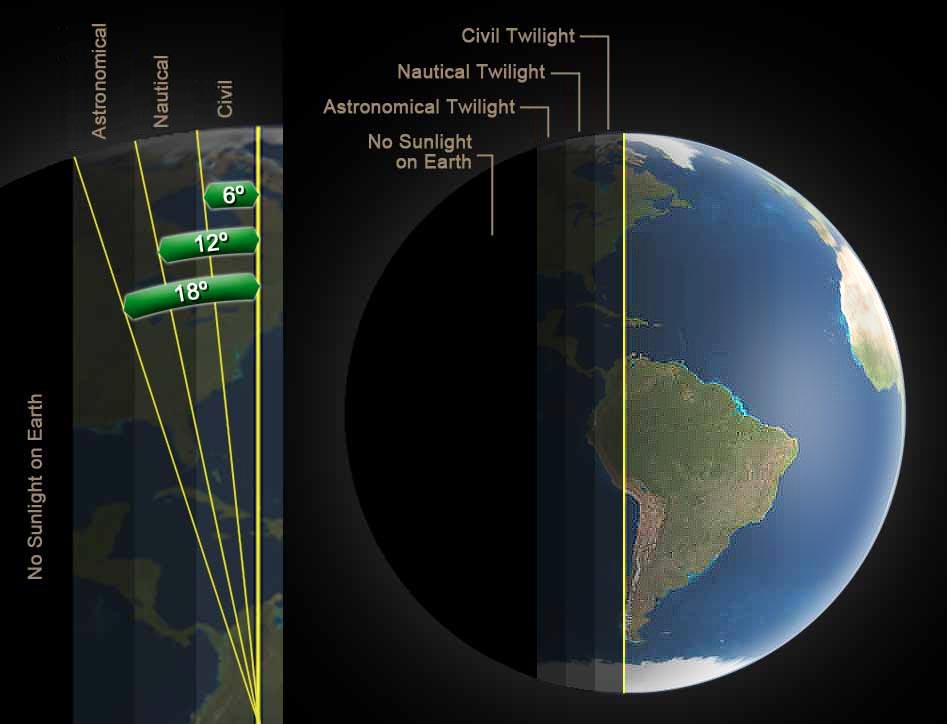

THE EFFECTS OF TWILIGHT
References to the daylight "half" and night-time "half" of Earth are really just convenient simplifi- cations. Actually, less than half of Earth is in darkness at any time due to the following factors. First, the Sun is immensely larger than Earth, so on purely geometric grounds its "direct rays" wrap slightly more than halfway around the globe—about 0.264° beyond its sunward half. This amount is not large, only about the width of the yellow vertical line in the full-Earth image above. Even so, if Earth had no atmosphere, the Sun still would be lighting about 180.528° of its sunward surface with "direct rays".
Of course, Earth does have an atmosphere, and it is the refraction and scattering of sunlight passing through it that produces our twilight. Atmospheric refraction at our planet's surface is significant. In fact, it displaces sky objects that we see at the horizon "upward" by an average of about 0.57°, or about 34 arc-minutes. Likewise, all the way around Earth—along its terminator, i.e. the constantly moving line that separates day from night on a planet, moon, etc.—is where sunlight strikes the atmosphere most "shallowly". Here it scatters and "spills past" Earth's terminator to "indirectly illuminate" a band of our globe beyond the portion receiving the Sun's "direct rays".
The "twilight" that results from these effects is typically divided into the three regions shown above. Because Earth rotates on its axis, the width of these regions indicate durations of twilight, which do not change overly drastically in the equatorial and middle latitudes. However, because of our planet's spherical shape and changing orientation relative to the Sun throughout the year, the length of twilight in different locations can be quite different as the seasons progress. The most extreme examples are seen as one approaches the poles, where twilight can last for weeks near the solstices!
The Classifications of Twilight
Civil Twilight is occurring on those parts of Earth where the Sun is below the horizon, but not more than 6°. When skies are clear the brightest planets and stars are already becoming visible during Civil Twilight, and the entire horizon is still easy to distinguish.
Nautical Twilight is occuring on those parts of Earth where the Sun is between 6° and 12° below the horizon. Nautical Twilight's name derives from the fact that at sea it still allows navigational readings of star and planet positions relative to the horizon. Even so, most persons would probably consider the sky dark at this time. By the end of Nautical Twi- light, the horizon has become too dim for accurate navigational readings.
Astronomical Twilight is occurring on those parts of Earth where Sun is between 12° and 18° below the horizon. Astronomical Twilight's name derives from the fact that, though the sky "appears" completely dark during this time, enough diffuse light remains in the atmos- phere to hinder observations of sky marvels that are quite dim—like Deep-Sky Objects (DSO's) and meteor showers.
In the diagram above the brightness of the bands of twilight has of course been exaggerated for emphasis. In reality illumination drops off gradually across these regions and from one to the next. Nonetheless, the sizes of the three bands are shown accurately, and it is easy to see that twilight can significantly reduce the time available for viewing the night sky. For this reason, many views of Earth on the SkyMarvels™ site try to account for twilight to give a more accurate depiction of our globe's shadow. You can see this on our Earth Tilt, Sunrise & Sunset page and Equinoxes & Solstices through March 2014 page.
Home Intro News Gallery Sky-Gifts Bonuses Tips
Learning Ctr Help Links Credits Legal Contact Us
© 2007-
by Gary M. Winter. All rights reserved.
Interested in political cartoons and humor?
Check out The HIPPLOMATS™.
SkyMarvels, Sky Marvels, SkyMarvels.com, Current Earth Sunrise and Sunset Views!, THE EFFECTS OF TWILIGHT!, Contrary to popular belief, Earth's night side is NOT half of the globe!, Civil Twilight, Nautical Twilight, Astronomical Twilight, celestiaforall, CELESTIA, astronomy, space, simulations, animations, downloadable astronomy posters, stars, planets, Inner Planets, Outer Planets, Inferior Planets, Superior Planets, moons, asteroids, comets, Oort Cloud, galaxy, galaxies, Milky Way, Andromeda, globular clusters, binaries, quasars, black holes, supermassive black holes, telescope, telescopes, planetarium, software, freestuff, satellites, add-ons, addons, scripts, eclipses, Solar Eclipses, Lunar Eclipses, Solar Eclipse Finder, Lunar Eclipse Finder, mutual eclipses, transits, occultations, Solar System, CELES-TOOLS, celeSTARrium, CELX, CELX programming, Freebies, multiple views, atronomical unit, light year, parsec, meteors, meteor showers, Perseids, Geminids, Leonids, barycenter, time, Time Zones, tides, alignments, conjunctions, oppositions, seasons, apogees, perigees, aphelion, perihelion, Earth, Luna, Mercury, Venus, Mars, Jupiter, Galilean Moons, Io, Europa, Ganymede, Callisto, Saturn, Titan, rings, Uranus, Neptune, Triton, E-MSpectrum, electromagnetic spectrum, astronaut, equinoxes, solstices, precession, rotation, spin, inclination, tilt, Ecliptic, orbits, ellipse, parabola, hyperbola
